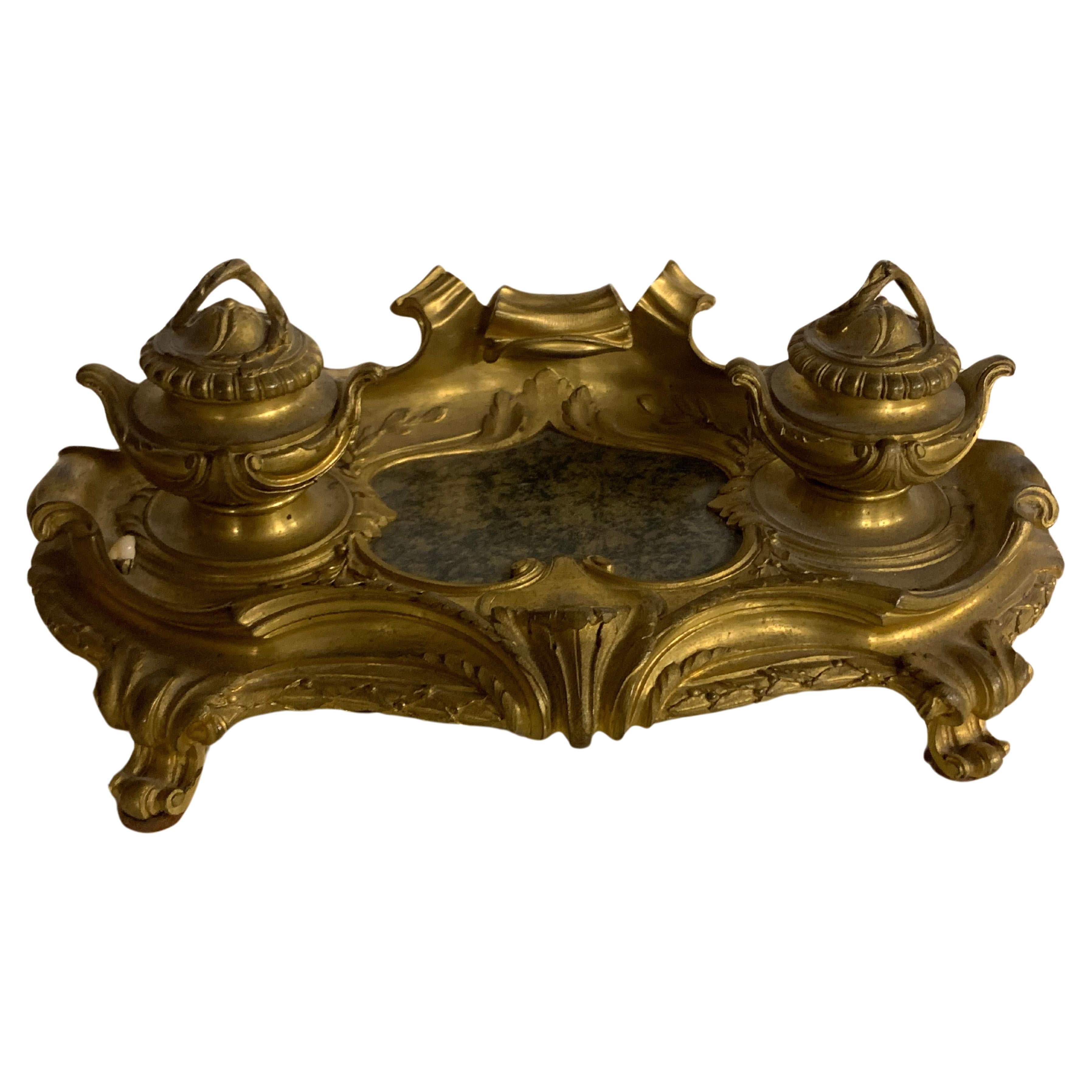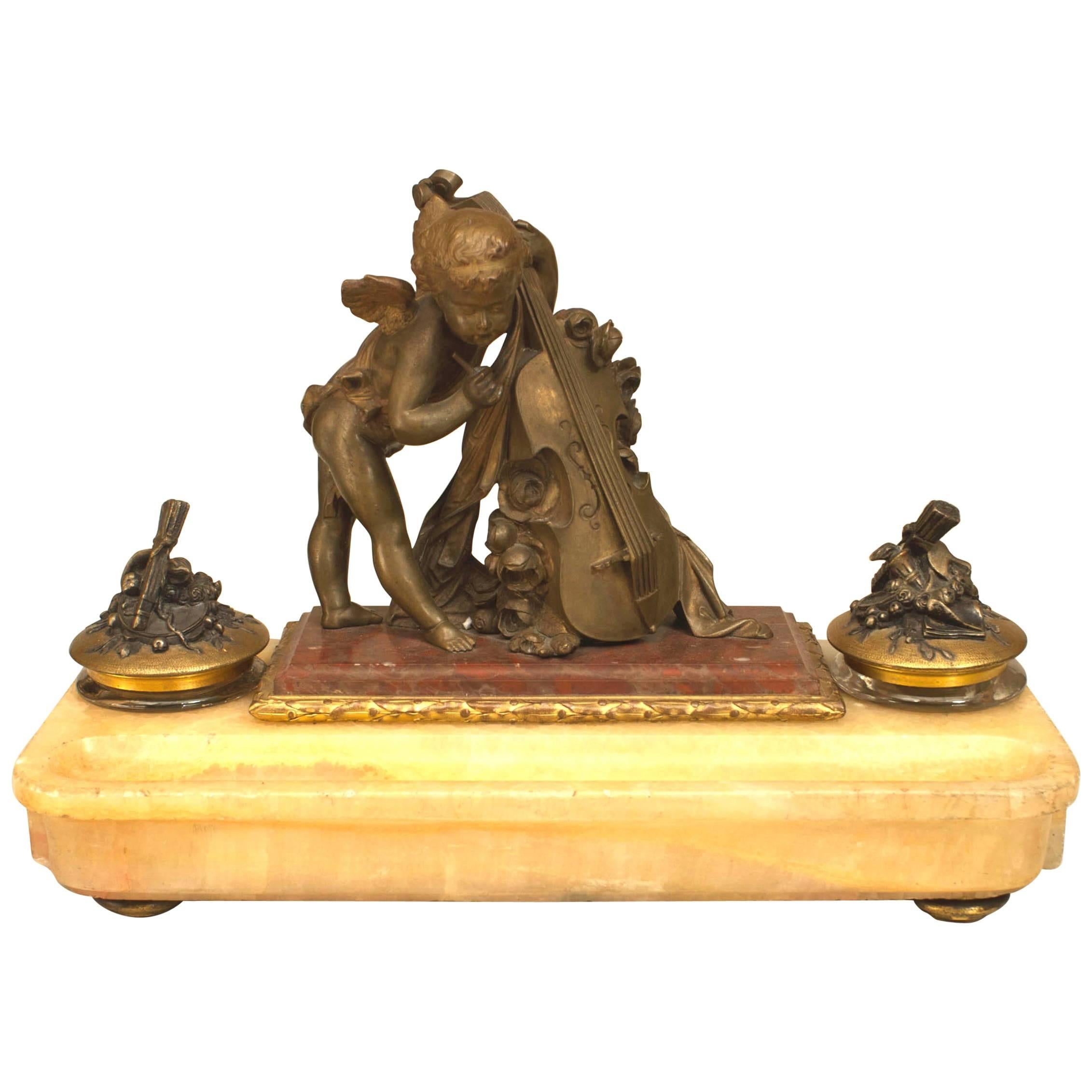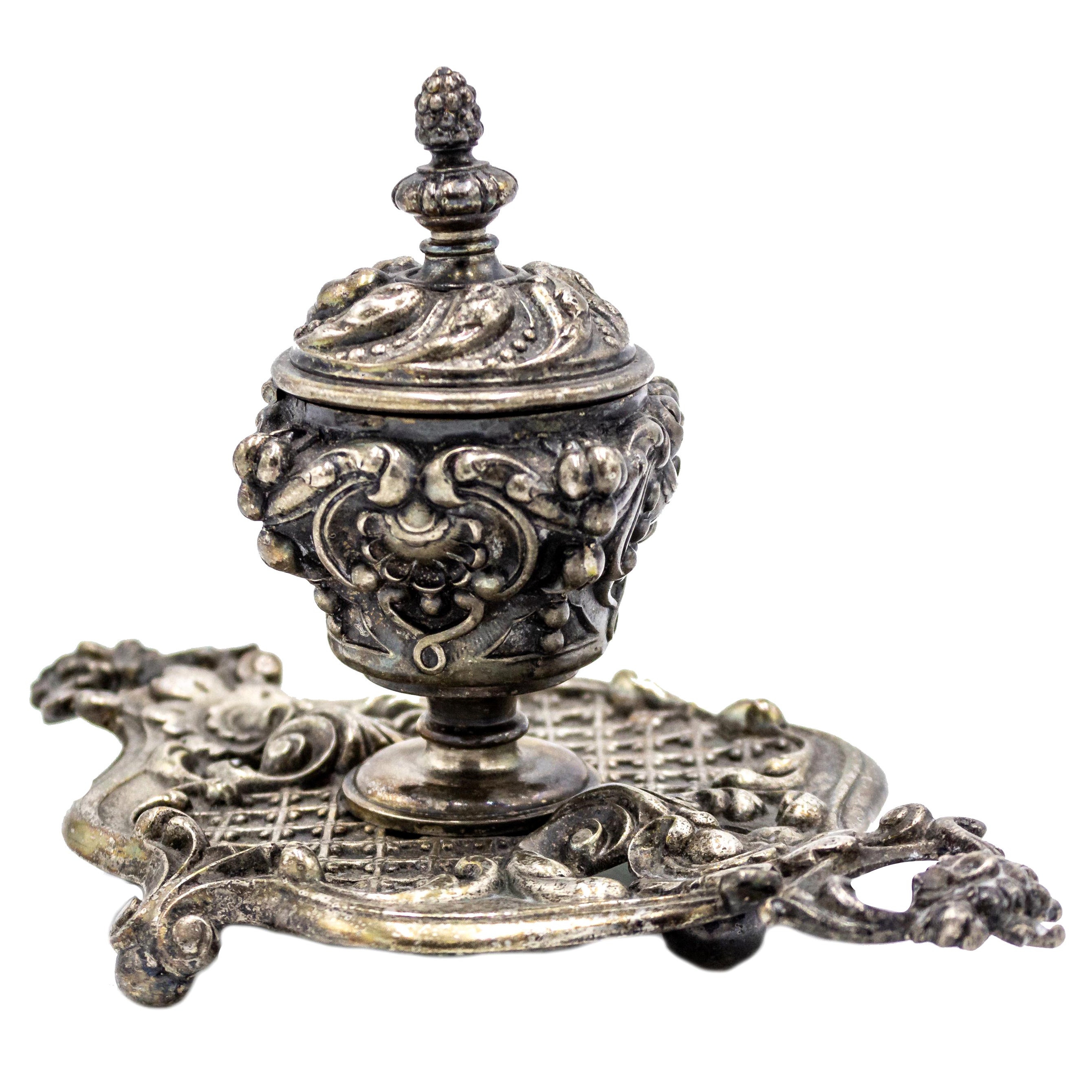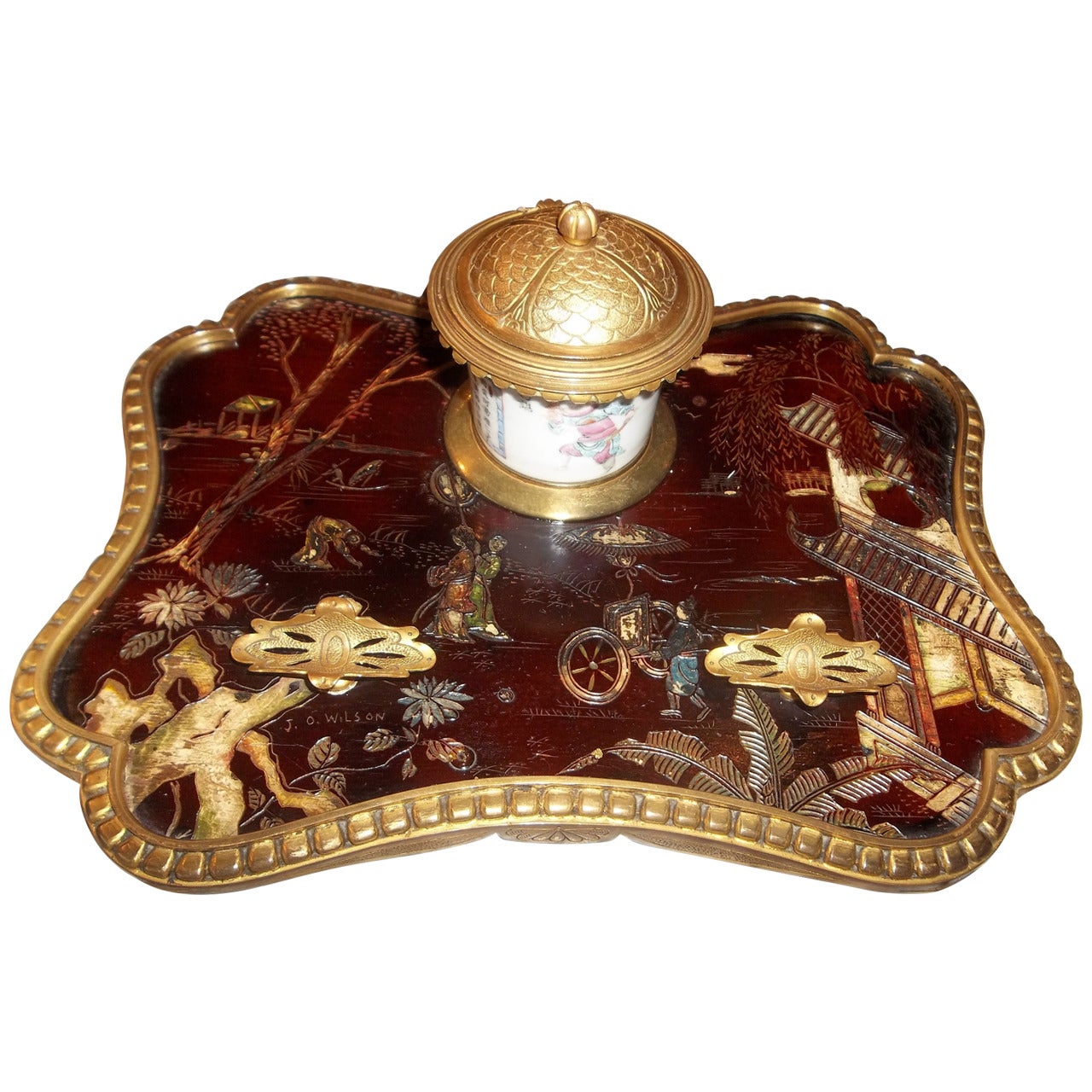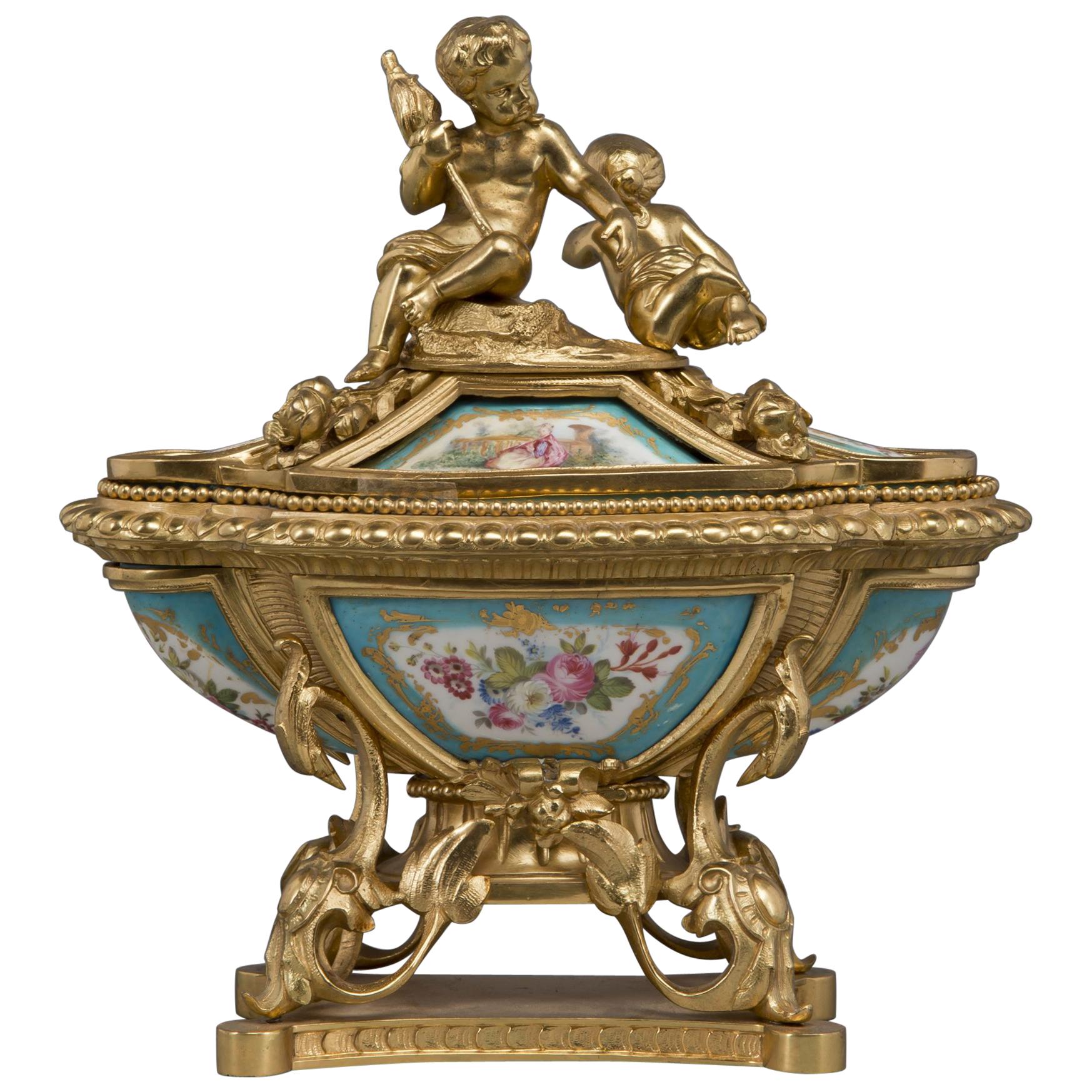Items Similar to Louis XV Style Inkwell, Designed by Léon Messagé and Cast By Barbedienne
Want more images or videos?
Request additional images or videos from the seller
1 of 7
Louis XV Style Inkwell, Designed by Léon Messagé and Cast By Barbedienne
About the Item
A Rare Louis XV Style Gilt-Bronze Inkwell. Designed by Léon Messagé and Cast By The Ferdinand Barbedienne Foundry, Paris.
Designed in the exuberant Rococo style surmounted by a seated figure of cupid as the messenger of love, reading a tablet and holding a torch. The shell-shaped basin cast with acanthus branches and leaves above two lidded wells.
This exceptional encrier (inkwell) was designed by Léon Messagé, the renowned sculptor who produced gilt-bronze mounts and sculptural work for François Linke's most magnificent exhibition furniture.
Signed 'L.Messagé Sc.', and with foundry mark 'F.BARBEDIENNE'
France, Circa 1895
Literature.
L. Messagé, Cahier des Dessins et Croquis Style Louis XV, Paris, 1890 pl.10 (the model illustrated).
C. Payne, François Linke, 1855-1946, The Belle Époque of French Furniture, Woodbridge, p. 72-73, pl. 67 (an identical model of this inkwell signed by Léon Messagé illustrated).
- Creator:Léon Messagé (Designer)
- Dimensions:Height: 27 in (68.58 cm)Width: 34 in (86.36 cm)Depth: 25 in (63.5 cm)
- Style:Rococo (In the Style Of)
- Materials and Techniques:
- Place of Origin:
- Period:
- Date of Manufacture:Circa 1895
- Condition:Wear consistent with age and use.
- Seller Location:Brighton, GB
- Reference Number:
About the Seller
5.0
Recognized Seller
These prestigious sellers are industry leaders and represent the highest echelon for item quality and design.
Platinum Seller
These expertly vetted sellers are 1stDibs' most experienced sellers and are rated highest by our customers.
Established in 1964
1stDibs seller since 2014
48 sales on 1stDibs
Typical response time: 1 hour
Associations
The British Antique Dealers' AssociationLAPADA - The Association of Arts & Antiques Dealers
- ShippingRetrieving quote...Ships From: Brighton, United Kingdom
- Return PolicyA return for this item may be initiated within 7 days of delivery.
More From This SellerView All
- Important Exhibition Encrier by François Linke and Léon Messagé, circa 1900By François LinkeLocated in Brighton, West SussexA very rare and important exhibition encrier by François Linke and Léon Messagé. French, circa 1900. Index number 709. Signed to the edge 'F. Linke'. This exceptional and ambitious encrier is modelled as two putti, each holding a standard and sitting on the water's edge, the two inkwells with hinged spirally-fluted covers with glass liners. This important inkwell is based on Léon Messagé's celebrated sculptural group 'La Source' and was originally intended by Linke to form part of his spectacular Stand at the 1900 Paris Exposition Universelle. Like seven or eight other pieces originally intended for inclusion on the Stand, it would seem the encrier was a casualty of both Linke's over-ambitious production schedule and the financial burden that the manufacture of such ornate and high quality work imposed. It was eventually shown on the Stand in September after the gilding was finished by Picard at a cost of 90 French francs. The costs of the model were very high: some 2024 francs (of which Message's combined fee was 1158 francs 40 centimes), underlining the originality and complexity. The 1900 Exposition example was sold, along with three important pieces of furniture from the Stand (the Grand bureau and associated armchair, and the Bahut Louis XV Mars et Vénus), to the South African banker and diamond merchant Solomon Joel. A further six encriers were produced up until 1925. Object Literature: Payne, Christopher. François Linke, 1855-1946, The Belle Époque of French Furniture, p. 90, pl. 97; p. 149, pl. 157; p. 150; pp. 182-183, pls 197 & 198 as exhibited at the Liege exhibition in 1905 & p. 480 for the original notes in Linke's Blue daybook of the late 1890s. François Linke (1855 - 1946) was the most important Parisian cabinet maker of the late nineteenth and early twentieth centuries, and possibly the most sought after cabinet maker of his period. He was born in 1855 in the small village of Pankraz, in what is now the Czech Republic. Records show that Linke served an apprenticeship with the master cabinetmaker Neumann, then in 1875 at the age of 20 he arrived in Paris where he lived until he died in 1946. It is known that the fledgling Linke workshops were active in Paris in the Faubourg St. Antoine as early as 1881, and during this time he supplied furniture for other more established makers such as Jansen and Krieger. The quality of Linke's craftsmanship was unsurpassed by any of his contemporaries and reached its peak with his spectacular Stand at the Paris Exposition Universelle in 1900, where his Grand Bureau took the Gold Medal. He gambled his fortune and reputation on this Stand, exhibiting several breathtaking items of furniture with sculptural mounts of the most exceptional quality and proportion. His gamble worked and his reputation was established to such an extent that Linke continued to be the pre-eminent furniture house in Paris until the Second World War. As the Art Journal reported in 1900 on Linke's Stand: 'The work of M. Linke ... was an example of what can be done by seeking inspiration amongst the Classic examples of Louis XV and XVI without in any great sense copying these great works. M. Linke's work was original in the true sense of the word, and as such commended itself to the intelligent seeker after the really artistic things of the Exhibition. Wonderful talent was employed in producing the magnificent pieces of furniture displayed....' The formation of Linke's distinctive style was made possible by his collaboration with the sculptor Léon Messagé. Together Linke and Messagé designed furniture for Linke's 1900 exhibition Stand, with exuberant allegorical figures cast in high relief, that exemplified Linke's ability to seamlessly merge the different mediums of wood carving, bronze and marquetry into a dynamic unified whole. Today Linke is best known for the exceptionally high quality of his work, as well as his individualism and inventiveness. All of his work has the finest, most lavish mounts, very often applied to comparatively simple carcasses. The technical brilliance of his work and the artistic change that it represented were never to be repeated. Bibliography: Payne, Christopher. François Linke, (1855 - 1946), The Belle Époque of French Furniture, Antique Collectors' Club, (Woodbridge, UK), 2003. Meyer, Jonathan. Great Exhibitions - London, New York, Paris, Philadelphia, 1851-1900, Antique Collectors' Club, (Woodbridge, UK), 2006; pp. 298 - 300. LeDoux - Lebard, Denise. Les Ébénistes du XIXe siècle, Les Editions de l'Amateur, (Paris), 1984; pp. 439-43. Revue Artistique & Industrielle, (Paris), July-August 1900. Coral Thomsen, D. (ed), The Paris Exhibition 1900, The Art Journal, 1901; p.341. Léon Messagé (1842-1901) had a brilliant, but short lived career. He is best known for his incredible sculptural collaboration with François Linke for the 1900 Paris Exposition Universelle. A gifted sculptor, Messagé was also responsible for much of the design and creative work for Roux et Brunet and Joseph-Emmanuel Zwiener. Messagé enjoyed great success as a designer/sculptor before his collaboration with Linke. Indeed he was mentioned as a Gold Medal winner at the 1889 International Exhibition and was especially praised for his work on a cabinet by Zwiener. He came into contact with Linke in 1885 and it appears from then on Linke employed him on a regular basis. Messagé was primarily influenced by Rococo ornament but he strove to re-interpret it. He did not produce slavish copies, and his original approach can be appreciated in Linke's celebrated Grande Bibliothèque and Grand Bureau exhibited at the 1900 Paris Exposition Universelle. A number of drawings by Messagé are recorded and after his success at the exhibition of 1889 he was encouraged to publish his designs. 'Cahier...Category
Antique Late 19th Century French Louis XV Inkwells
MaterialsBronze
- Louis XV Style Vitrine Table, François Linke and Léon Messagé French, circa 1900By François LinkeLocated in Brighton, West SussexA fine Louis XV Style gilt bronze mounted table Vitrine, by François Linke, the mounts designed by Léon Messagé. Index Number 131. This elegant tabl...Category
20th Century French Louis XV Center Tables
MaterialsBronze
- Fine Louis XV Style Gilt-Bronze and Sèvres Style Porcelain Inkwell, circa 1890By Manufacture Nationale de SèvresLocated in Brighton, West SussexA fine Louis XV Style gilt bronze and Sèvres style Porcelain inkwell. French, circa 1890. This elegant and sophisticated inkwell is of sarcophagus form with finely painted por...Category
Antique Late 19th Century French Louis XV Inkwells
MaterialsBronze
- Louis XV Style Gilt-Bronze Encrier by Paul Sormani, French c 1870By Paul SormaniLocated in Brighton, West SussexA Rare Louis XV Style gilt bronze Encrier, By Paul Sormani. French, circa 1870. Signed 'P. Sormani, Paris' to the underside of the cover. Thi...Category
Antique Late 19th Century French Louis XV Inkwells
MaterialsBronze
- Napoleon III Clock Garniture Designed by Sévin, Cast by BarbedienneBy F. Barbedienne Foundry, Louis-Constant SevinLocated in Brighton, West SussexA fine Napoleon III gilt-bronze and porcelain mounted clock garniture, designed by Louis-Constant Sévin, cast by Ferdinand Barbedienne, The Movement by Japy Frères. Frédéric Japy ...Category
Antique 19th Century French Napoleon III Mantel Clocks
MaterialsOrmolu
- Large and Finely Cast Neo-Grec Jardinière by Ferdinand BarbedienneBy Ferdinand BarbedienneLocated in Brighton, West SussexA large and finely cast neo-grec gilt and patinated bronze jardinière by Ferdinand Barbedienne. Signed 'F. BARBEDIENNE'. This rare Jardinière or ...Category
Antique 19th Century French Neoclassical Revival Planters, Cachepots and...
MaterialsBronze
You May Also Like
- Inkwell in bronze louis XV styleLocated in Los Angeles, CALouis XV style bronze inkwell ,in the middle you have a marble plaque in the shape of a heart ,the bronze are finely executed,original condition Extremly rare this inkwell have its...Category
Antique 1890s French Louis XV Inkwells
MaterialsBronze
- French Louis XV Style Bronze Double InkwellLocated in New York, NYFrench Louis XV-style (19th Century) bronze double inkwell with trophy caps and cupid playing the cello on a white onyx base.Category
Antique 19th Century French Louis XV Inkwells
MaterialsOnyx, Bronze
- French Louis XV Silver and Bronze InkwellLocated in New York, NYFrench Louis XV-style (19/20th Century) silver plate on bronze oval shaped inkwell with handles and acorn finial.Category
Antique 19th Century Louis XV Inkwells
MaterialsSilver, Bronze
- Japanned or Chinoiserie Decorated Louis XV Style Lacquer InkwellLocated in Nashville, TNThe lacquer ground with a strong burgundy undertone. Well carved , colored and other wise decorated . The porcelain well in good Antique condition . Minor wear due to age and use .Category
Antique 1860s French Louis XV Inkwells
MaterialsLacquer
- French Louis XV Miniature Secretary InkwellLocated in New York, NYFrench Louis XV-style (19th Century) inkwell stand in the form of a miniature secretary with roll top and etched glass doors.Category
Antique 19th Century Louis XV Inkwells
MaterialsGlass, Walnut
- Antique Inkwell from Bronze and Ceramic, France, circa 1880, Louis XV StyleLocated in Greven, DEExceptional antique Inkwell with rich bronze ornaments and three ceramic vessels. The ink jars are painted in a beautiful rich green and embellished with gold colour. France, circa...Category
Antique Late 19th Century French Louis XV Inkwells
MaterialsBronze
Recently Viewed
View AllMore Ways To Browse
Inkwell Monkeys
Bronze And Glass Desk
Edwardian Silver Inkstand
Inkwell Limoges
Silver Capstan Inkwell
Stag Inkwell
Antique Fountain Pen Holder
Bakelite Inkwell
Elephant Inkwell
Frog Inkwell
Hare Inkwell
Hunting Dog Inkwell
Jacob Petit Inkwell
Lobster Decorative Accessories
Loetz Inkwell
Male Nude Inkwell
Mermaid Stained Glass
Retro Inkwell And Pen Holder

